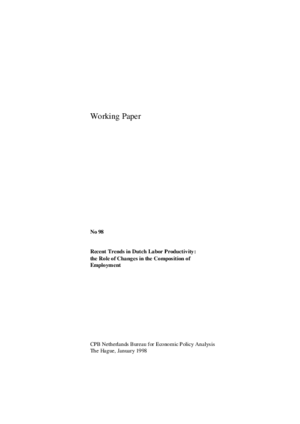Recent trends in Dutch labor productivity: the role of changes in the composition of employment
However, the recent slowdown may in part be due to the rising employment share of workers with lower levels of productivity, possibly as a consequence of deliberate government policies . To the extent that the latter explanation is correct, the productivity slowdown is only temporary.
This report starts off with an empirical overview of productivity growth in the Netherlands. After reviewing problems of measuring and comparing productivity, empirical evidence on the recent productivity slowdown is presented. It is concluded that the Netherlands still ranks very high in terms of GDP per hour worked. However, the lead of the Netherlands over other countries is diminishing. GDP growth per hour worked fell sharply in the second half of the 1970s, from more than 5% per year to about 2% per year. A further decline has been recorded since the mid-1980s from about 2% to about 1% to 1«% per year.
The report then turns to the role of changes in employment composition in the recent productivity slowdown. It is shown that changes in employment composition along the dimensions age, education, gender, full-time/part-time employment and sector of employment cannot explain the recent slowdown. However, shifts in the wage distribution do indicate a rise in the employment share of workers with lower productivity, at least if one assumes that wage differentials reflect productivity differentials. One reason for a rising employment share of workers with lower productivity is the nominal freeze of the statutory minimum wage during much of the 1980s and 1990s. Simulations with MIMIC, CPB's applied general equilibrium model, indicate that this may indeed have lowered aggregate labor productivity. Thus, on balance, the available evidence indicates that employment composition effects did play a role in the productivity slowdown.
